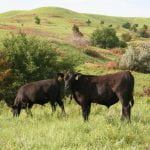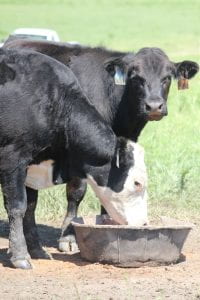Dale Blasi, Stocker, Forages, Nutrition and Management specialist and Justin Waggoner, Beef Systems Specialist, Garden City
 As the 2023 grazing season approaches, stocker operators might consider various strategies to protect their risks against the market and drought conditions.
As the 2023 grazing season approaches, stocker operators might consider various strategies to protect their risks against the market and drought conditions.
If not already accomplished, producers are making their cattle purchase decisions for their intended pasturing needs. Based on historical stocking rates and the need to adjust according to existing pasture conditions from drought, producers will attempt to purchase the number as well as the size and type of the calf that can be “bought for the money.”
- Pre-grass feeding strategy considerations
Producers who already have purchased calves for grass are either backgrounding calves in a holding pattern or minimally managing them on dormant winter grass in anticipation of the opportunity to exploit compensatory gain that can be realized when cattle are placed on actively growing native pastures in April or early May.
A research trial (Anglin et al., 2008) was conducted in 2007 at the KSU Beef Stocker Unit to evaluate the long-term effects of limit feeding on subsequent performance on native pasture. The takeaway from this trial was that limit-feeding 2.25% in the dry lot before going to grass decreased feed costs. Calves that were limit fed experienced higher daily gains during the subsequent grazing period at a lower cost per pound of gain. Calves limit-fed during the background phase gained 15 pounds more than the free-choice-fed steers.
- Know the variation in weight of your calves going to grass
There may be a 250 to 300 pounds range in the lightest to the heaviest calf in a set of calves going to grass. Under the prospects of rapidly diminishing forage production from drought, producers could consider pulling the heavier calves from the grass at midseason and going either to market or beating the rush of calves headed to feed yards. Over the years, KSU has evaluated this practice (Owensby et al., 2008; Harmoney and Jaeger, 2011 and 2015) and have concluded that this modification of intensive early stocking improves flexibility for drought conditions. If producers have the capability to individually weigh animals; identifying the heaviest cattle within a group (different tag color) prior to turnout will make gathering and removing these cattle from pastures considerably easier.
- Feed and mineral inputs are exceptionally expensive this year; be prudent with their use
The consumption of self-fed mineral supplements should be closely monitored. Excessive consumption is often the result of the animal’s desire for additional salt. For example, if a complete mineral supplement costs around $500 with a labeled consumption of 4 ounces/head/day over 90 days, this calculated cost is about 5.63 dollars per head with no labor for pasture delivery included. If mineral consumption is excessive (6 ounces rather than the bag recommendation of 4), the actual cost will be $8.45/head.
If the value of gain is less than the cost of implementing a mineral supplementation program, producers may opt to provide only salt blocks. Previous research (Weibert et al., 2018) showed a reduction of daily gain of .1/lb/day when providing salt blocks vs. a complete mineral.

 Objective: The overall objective of this study was to evaluate management practices that may impact stocker steer gains on a 90-day double stocking grazing system in tallgrass native range. Specific objectives include evaluating the timing of burning, addition of spices in a complete free-choice mineral, and determination if the effects are additive.
Objective: The overall objective of this study was to evaluate management practices that may impact stocker steer gains on a 90-day double stocking grazing system in tallgrass native range. Specific objectives include evaluating the timing of burning, addition of spices in a complete free-choice mineral, and determination if the effects are additive.